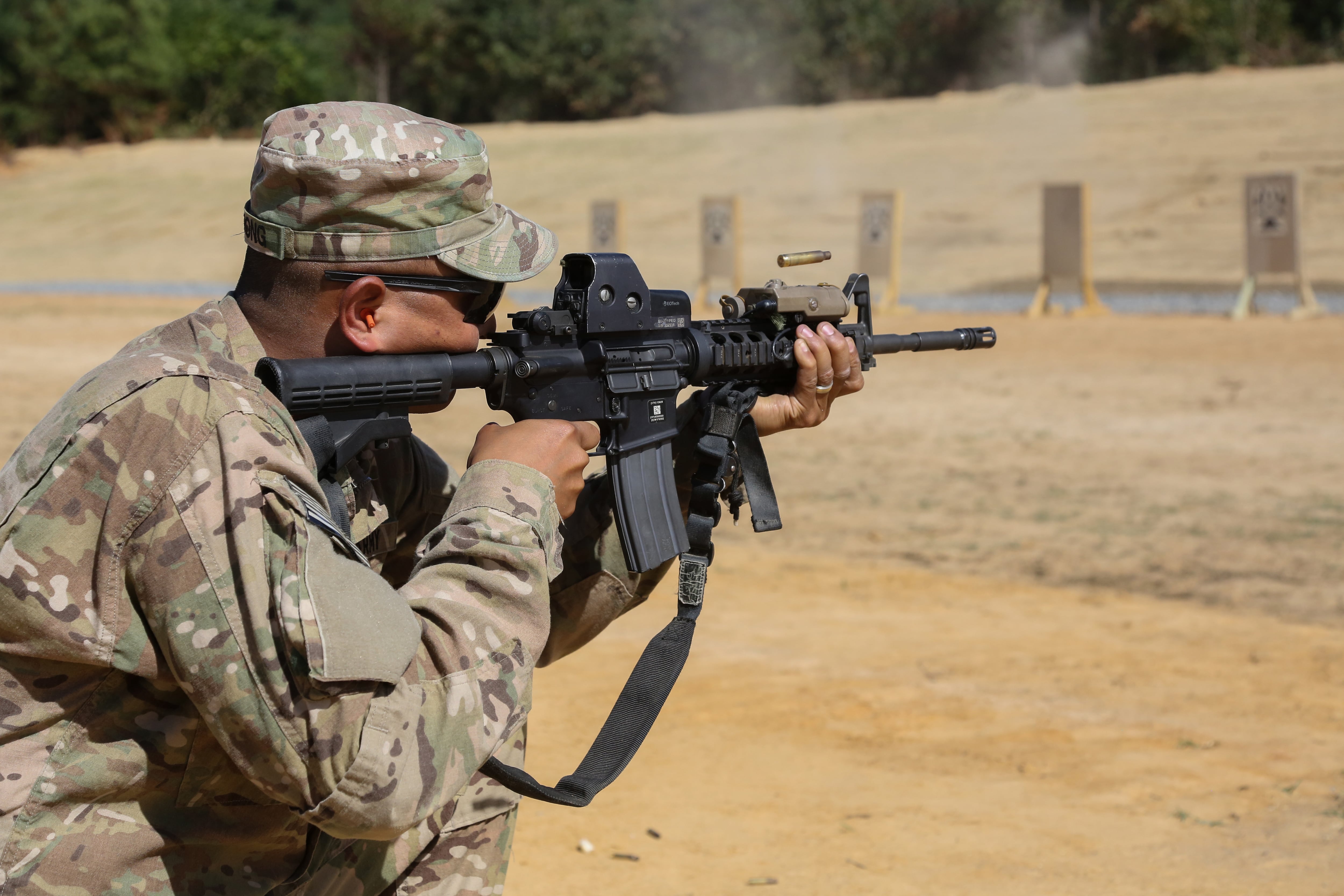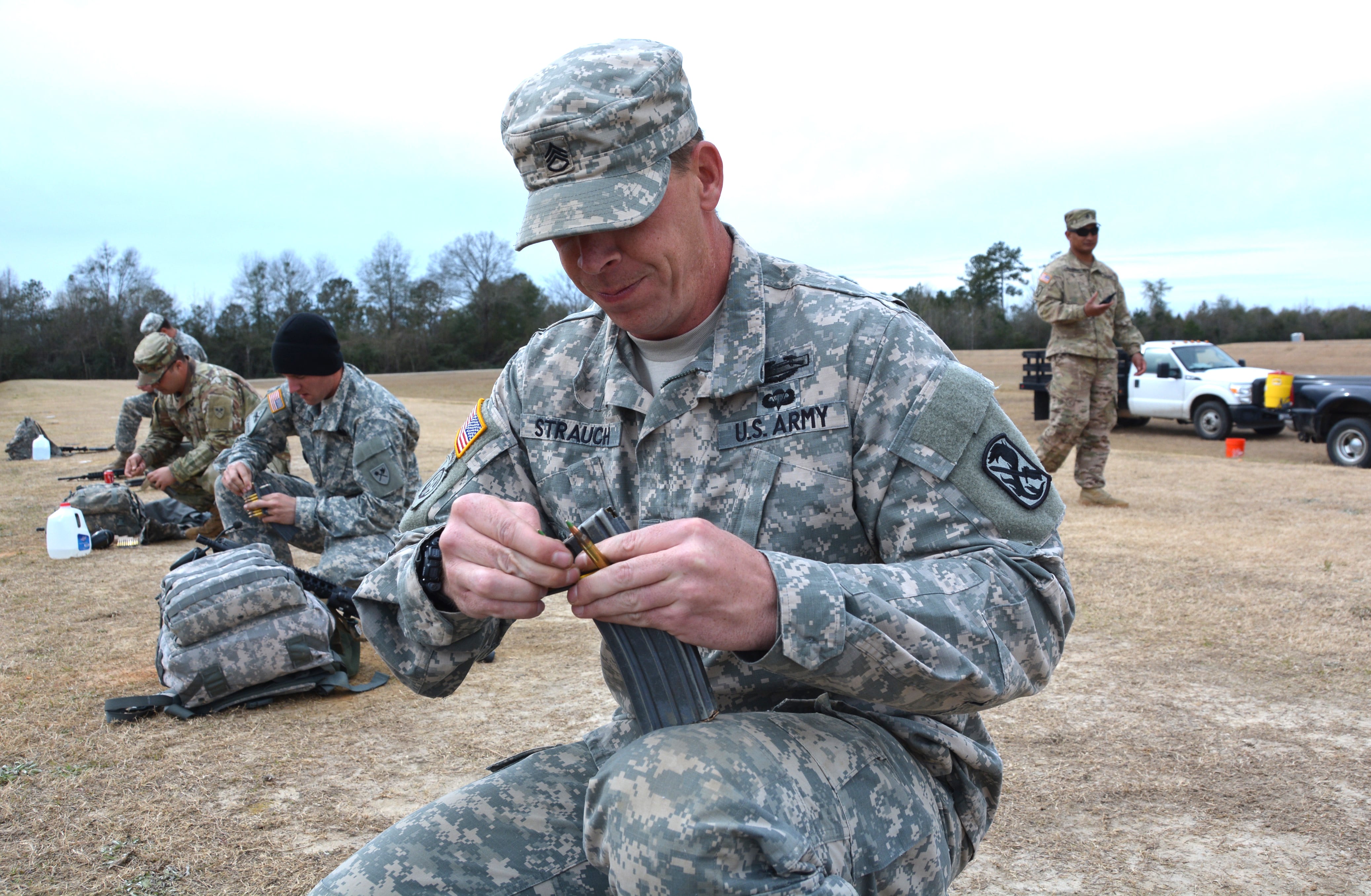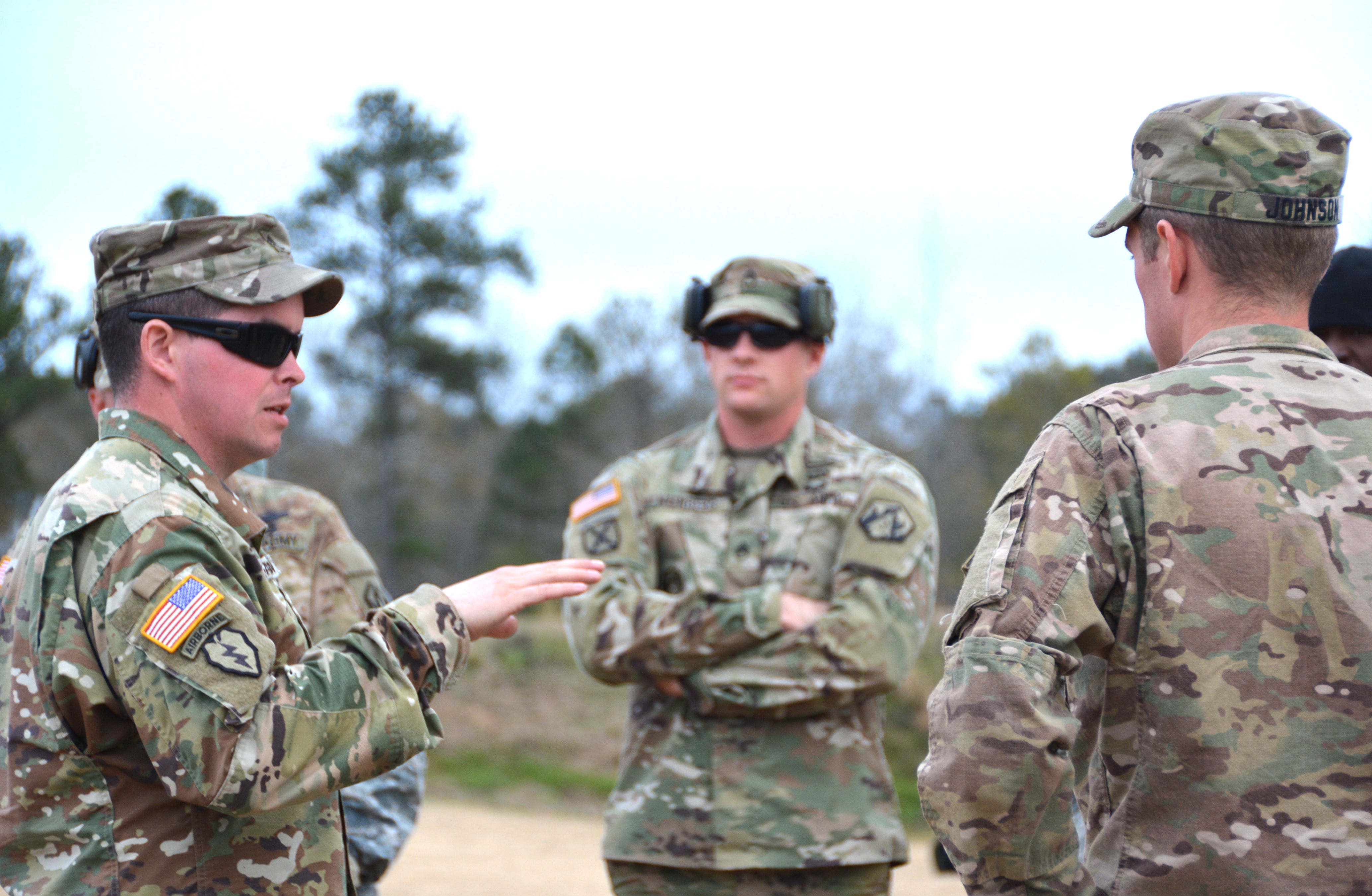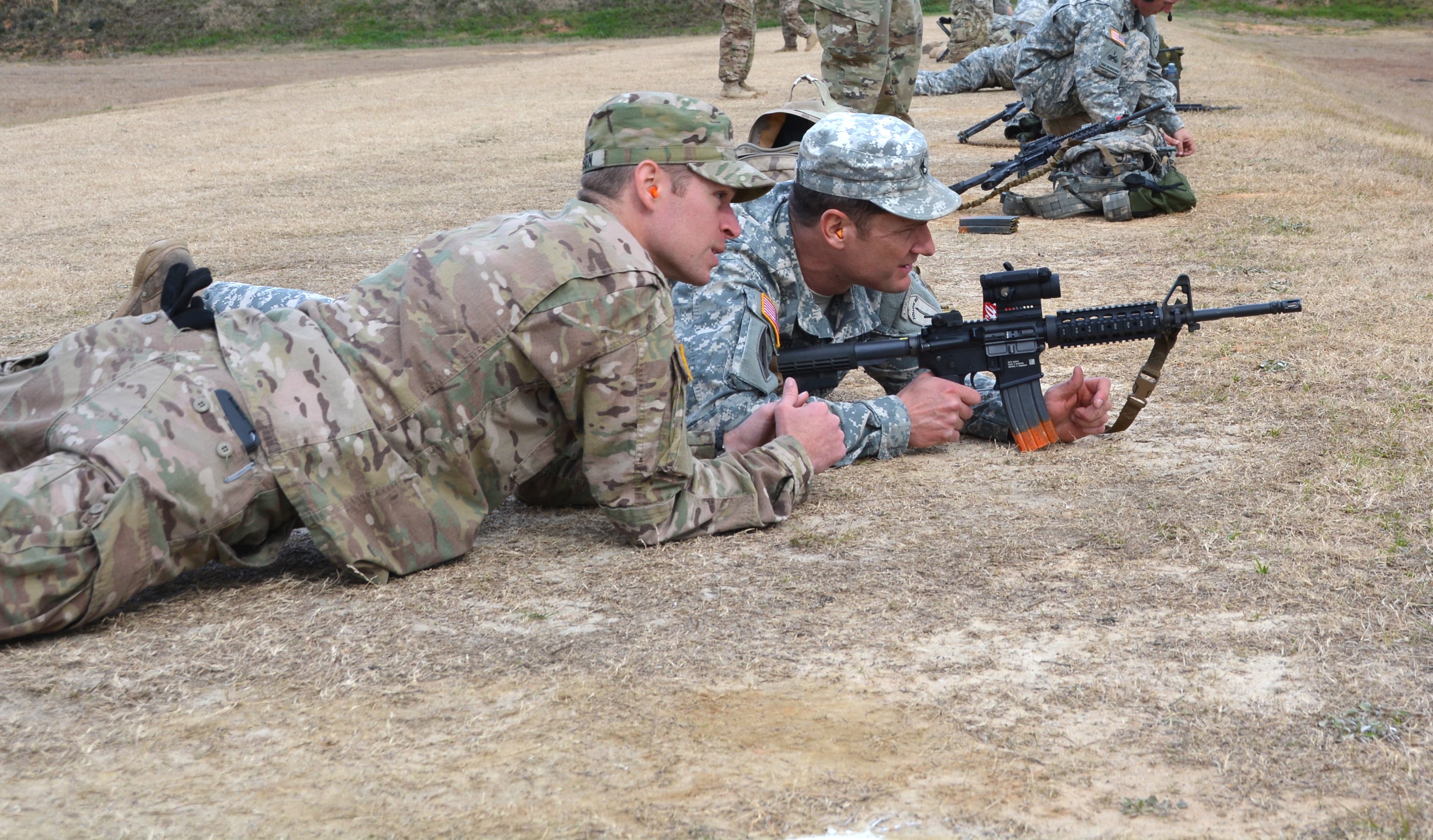The Army is launching a training course to fix a deficit in one of the most fundamental skills of soldiering: shooting straight.
The Marksmanship Master Trainer Course was first stood up by the U.S. Army Marksmanship Unit, the service's elite competitive shooters. This spring, it will launch Army-wide and fall under the 316th Cavalry Brigade. The course is already available on the Army Training Requirements and Resources System, or ATRRS.
Soldiers must be well-versed in the basics of soldiering, said Maj. Gen. Scott Miller, commanding general of the Maneuver Center of Excellence and Fort Benning, Georgia.
"If you don't have the foundational skills, you don't get better when we put more stress on you," he said.
Leaders believe so strongly in the course that graduates will receive an Additional Skill Identifier (which is still in the works and does not yet have a number or letter designation).
"We think it's important that people who come through this are identified, so as a company or battalion-level command team, you can start identifying these individuals as they come in, and we can help manage them better, too," Miller said.
The hope is for the MMTC to help the Army fill a gap in its marksmanship abilities, said Capt. James Pickett, the operations officer for the Army Marksmanship Unit.
"It's a fix for a problem, but I think it's important we not focus on the problem," he said. "This knowledge did atrophy, but it atrophied naturally. Think about all the deployments [soldiers did]. How much time do you think they really had to focus on stuff?"

Army leaders are sharpening soldiers' marksmanship skills to bring more of them to the expert level. Here, Sgt. Arthur Ruepong, assigned to the 55th Signal Company (Combat Camera), fires his M4 during a field training exercise at Fort A.P. Hill, Va., in September.
Photo Credit: Sgt. 1st Class Christophe Paul/Army
The MMTC was born out of a recent Maneuver Warfighter Conference and backed by Miller.
After almost 15 years of war in Iraq and Afghanistan, "maybe we'd lost the essence of being able to focus on the basics," he said.
As the Maneuver Center of Excellence looked at the areas it should focus on, "from the standpoint of lethality," leaders began to examine soldiers' proficiency with their individual weapons, Miller said.
"When you start talking about basic rifle marksmanship, it's actually very measurable," he said. "When we looked across the force, what we wanted to do was move more of our shooters to the expert level. It's a trainable skill."
Soldiers who score a 36 or higher out of 40 targets during weapons qualification qualify as expert marksmen. Those who hit 30 to 35 of the 40 targets are sharpshooters, while those who score a 23 through 29 are marksmen. Soldiers who shoot 22 or lower do not qualify.

Staff Sgt. Joel Strauch, 1st Battalion, 19th Infantry, 198th Infantry Brigade, loads magazines Jan. 26 at McAndrews Range. The Sand Hill drill sergeant is attending the Marksmanship Master Trainer Course that trains soldiers to teach marksmanship to other soldiers. The course has been added to the Army Training Requirements and Resources System this year.
Photo Credit: Brenda Rolin/Army
Leaders "didn't like where our numbers were" in terms of how many soldiers were qualifying as experts, Miller said.
But the issue wasn't just in the scores, Miller said. It was in resources as well.
"The biggest shortfall is trained personnel to train soldiers," he said, adding that basic rifle marksmanship is "a skill you generally don't lose if you learn it right the first time."
"If you don't teach them right the first time, you have this self-perpetuating problem," Miller said.
The ability to plan and resource training is another skill set that likely has atrophied over the course of almost 15 years of war, Miller said.
"What the Army has gotten used to is you have trainers come to you," he said. "But if you just show up to training as opposed to planning training, that's a skill that can atrophy."
The problem isn't poor noncommissioned officers, said Lt. Col. Bret Tecklenburg, commander of the Army Marksmanship Unit.
"We've culturally lost the ability to teach soldiers how to train and shoot marksmanship," he said. "To fix it, we have to equip NCOs to do their duties. Without the information they need, they can't do it."
One big challenge facing the Army is time — or the lack thereof.
"When you have quite a few requirements levied on you, you start mixing and matching what's important," Miller said.
Some shooters have the aptitude and foundational knowledge to only need three or four days to get up to speed, he said. Others need more time.
"You need to anticipate more time because we have to get basic marksmanship right," he said.
In his assessment, Miller said he believes the Army can do better when it comes to marksmanship.
"I didn't see it as a catastrophic failure," he said. "I thought we could do much better and drive up our expectations."
The marksmanship initiatives are already producing results.
Experts at the Maneuver Center measured a One Station Unit Training infantry unit within the 198th Infantry Brigade.
Two years ago, 52 percent of the soldiers were qualifying as marksmen, the minimum standard, said Col. Geoffrey Norman, the operations officer for the Maneuver Center. Of the others, 38 percent qualified as sharpshooters and 10 percent as experts.
Since then, the unit has made changes to its marksmanship training strategy and integrated MMTC-certified trainers, Norman said. A snapshot of the unit's marksmanship scores taken in December showed a 40 percent reduction in soldiers qualifying as marksmen, he said.
In December, just 12 percent of the soldiers were qualifying as marksmen. As many as 34 percent qualified as experts and 54 percent as sharpshooters.
"Their numbers are representative of the returns on investment for this program," Norman said. "[The Maneuver Center] envisions an increase in sharpshooters and experts, people who are real masters of their weapons. We've seen a huge reduction in folks just getting by."
Pickett said the shortfalls in marksmanship abilities and knowledge across the force were "obvious" to him.
"I can definitely tell you what I struggled most in was trying to get people to understand how to shoot and how to teach shooting," he said.
Sgt. 1st Class Kenneth Rose, chief of the AMU instructor training group, agreed, adding that there is a lot of misinformation in the force about shooting and marksmanship.
They include a lack of understanding when it comes to basic ballistics and what happens to a bullet after it leaves the barrel.
"Some people thought a bullet accelerated once it was fired," Pickett said. "But it's really a struggle against gravity the minute it leaves, and it's [traveling] a downward arc."
Plenty of soldiers, regardless of rank, had that misconception, Pickett said.
Some soldiers also didn't understand how to adjust the sights on their rifles, Rose said. Others didn't understand minute of angle, which is a way to measure a rifle's accuracy, and how it affects shot groups. Still others don't know how to zero the iron sights on their rifles because they've only learned to do so with optics.
Pickett credited Miller for pushing for the MMTC.
"He recognized that there was a huge knowledge gap in marksmanship and that knowledge gap particularly affected the NCOs' ability to teach marksmanship effectively at their unit," he said.
This includes the ability to plan training events and knowing how to get the required resources, such as ammunition and ranges, for training, Pickett said.
The first MMTC kicked off in late 2014, Rose said. To date, more than 230 NCOs have graduated as marksmanship master trainers, he said.
The first soldiers to attend the course included drill sergeants and soldiers at the marksmanship academy at Fort Drum, New York, Rose said.
"Now we're continuing to target E-5 to E-7 [soldiers] but we're opening that up to whoever needs the training," he said.
Now that MMTC has been approved as a Training and Doctrine Command course, it's time for AMU to hand off the day-to-day responsibilities of the course to the Maneuver Center of Excellence, Tecklenburg said.
"We're responsible for helping the Army with marksmanship, but we don't have a large cadre of instructors," he said.
The unit only has about 140 personnel, about 100 of them soldiers.
The biggest challenge facing the MMTC is capacity, Tecklenburg said.
"With only a few courses run and the capacity of putting in 30 at a time, we have thousands of NCOs that we need to reach," he said.
For Tecklenburg, "ultimately, success is when units are running their own marksmanship training within their units," he said.
The Maneuver Center of Excellence's 316th Cavalry Brigade, which is responsible for the master gunner and sniper schools, will partner with AMU to run the Marksmanship Master Trainer Course, said Lt. Col. Bob Underwood, deputy commander of the 316th Cavalry Brigade.
"We were a natural fit for putting the course into the long-term institutional process," he said. "We're the long-term manning solution, but the execution of the course is still going to be a partnership with AMU."
Day-to-day, soldiers from 1st Battalion, 29th Infantry, which is part of the 316th Cavalry Brigade, will run the course.
The plan is to run three pilot courses on ATRRS; in April, June and August, Underwood said.
The pilots will validate the course as it goes Army-wide, said Richard Eggers, who oversees training management for the 316th Cavalry Brigade.
"The curriculum is never static within the educational realm, so you're always improving it," he said.
The MMTC is similar to the master gunner courses that already exist for Bradley and tank gunners, except instead of focusing on a specific platform, MMTC focuses on the individual, Underwood said.
"It's really about excellence," he said. "It's about getting beyond basic marksmanship and driving towards being excellent in the fundamentals of marksmanship."
Once the MMTC is up and running, the 316th Cavalry Brigade can run as many as 15 courses a year. Each class can hold 30 students at a time. Students are supplied with weapons, optics and ammunition.
The primary cost of running the course is ammunition; each course costs about $50,000 to run, Underwood said.
Soldiers who attend MMTC must successfully complete a "shoot-in process," Rose said.
On their first day, students must zero a rifle and shoot, using iron sights, at least 23 out of 40 targets — the bare minimum to qualify on a rifle — to remain in the course, he said.
"We ask you to clear a hurdle right out of the gate," Pickett said. "[The course] is five weeks, we have a lot of material to cover, so we look for a baseline of capability so we know that unit isn't wasting their time and money by sending that guy, and our instructors aren't having their time wasted, either."

Staff Sgt. Logan Gaughan, left, Marksmanship Master Trainer Course instructor, gives a brief to MMTC students Jan. 26. The five-week course trains soldiers to teach marksmanship and was developed by the U.S. Army Marksmanship Unit.
Photo Credit: Brenda Rolin/Army
MMTC is unique because it doesn't just teach NCOs how to shoot, Rose said.
"We're actually teaching those noncommissioned officers how to teach others," he said. "A lot of the curriculum is based around not only their knowledge and ability to shoot, but also how they articulate that knowledge and teach it."
During the course, students will use standard equipment that is easily available across the Army, Rose said.
This means they'll train with standard, rack-grade M4 carbine and the M855 green-tipped ammunition that's standard issue, he said.
The instructors at AMU also "took great care" to make sure the course was conducted on ranges that can be found anywhere in the Army, Rose said. None of the training takes place on "ranges specific to AMU," he said.
"We want them to take this training back to the force and use the ranges they already have," he said.
The MMTC is the most comprehensive train-the-trainer program put together by AMU, Pickett said. It also will be the first course designed by the unit to become a full-fledged Army-wide course via ATRRS, he said.
"What you get out of a graduate is really a force multiplier for any echelon that he's assigned to," Pickett said.
AMU also is working to get the word out to commanders about the abilities of a course graduate. This includes briefing soon-to-be command teams attending the Pre-Command Course on post.
"It's great because we give them a shooting demonstration, how we do blocks of instruction, and let them shoot a little," Rose said. "When they get an MMTC graduate in their formations, they know what they're capable of and how they can be used."
So far, graduates of the MMTC have been surprised by how much they learn, Rose said.
"Usually the first week they spend here, we debunk a lot of myths, and we're not just telling them, we're getting out and showing them," he said. "It's going to change the way that soldiers think about shooting."
Michelle Tan is the editor of Army Times and Air Force Times. She has covered the military for Military Times since 2005, and has embedded with U.S. troops in Iraq, Afghanistan, Kuwait, Haiti, Gabon and the Horn of Africa.





